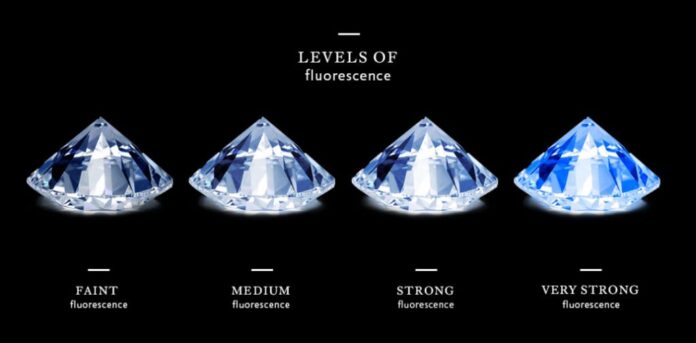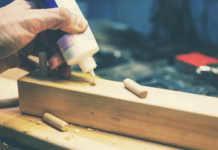Look at the diamond in various lighting circumstances, such as natural daylight, and compare it to other diamonds of the same color if you’re considering purchasing one. Make a note of any alterations. Many customers have this question “Is fluorescence in diamonds good or bad?”.
Because the impression of diamond fluorescence is so subjective, it generates a lot of discussions. Opinions span from one extreme to the other. Check it out the next time you’re in a jewelry store and decide if it appeals to you. You should be pleased with your purchase. There are no hard and fast rules, so follow your heart.
Fluorescence in Diamond
When subjected to ultraviolet light, various hues and intensities of visible light can be released from diamonds. Indoor fluorescent lighting and sunlight both contain varying amounts of ultraviolet lite radiation. Fluorescence has become a common feature in diamonds on the market. Most flash blue but white, yellow, orange, and red fluorescence have also been detected on rare occasions.
The tiny structures inside the crystal are what make thediamond glow. Blue fluorescence is usually caused by nitrogen atoms lined in describing patterns inside the carbon lattice. Most of the time, fluorescence is just a way to tell what something is, not how well it works, so it is neither good nor bad.
Is Fluorescence in diamonds good?
As the distance from the light source increases, the fluorescence influence diminishes rapidly; according to my research, Fluorescence cannot be observed in almost any common indoor viewing condition because the light source is too far away. That fluorescence makes diamonds of weaker colors appear more significant is, therefore, largely incorrect. Because of this, it is often neither good nor bad in terms of visual quality, especially when worn with one of our diamond engagement rings.
Colorless diamonds are penalized in the market based on the degree of their fluorescence. To put it another way, a D color with an Extremely Strong fluorescence would be badly undercut. There is minimal impact on the value of lower-color diamonds due to fluorescence. It is assumed that these gems can benefit from the property’s whitening potential, provided transparency is not affected and color overgrazing hasn’t occurred.
Does Fluorescence make diamonds look better?
Contrary to what many in the diamond industry and the general public believe, fluorescence does not improve a diamond’s beauty. Diverse hues and fluorescence intensities of diamonds were utilized in the experiment, which involved three unique sets of observers: laboratory graders, jewelry industry professionals, and the general public. The diamonds were examined under different lighting settings.
According to my study, the effect of diamond fluorescence on its visual quality is negligible. It should be noted that the test sets used in this study did not contain over-blues, which are intensely blue fluorescent diamonds with pronounced milkiness. Download the complete GIA paper, A Contribution to Understanding the Effect of Blue Fluorescence on the Appearance of Diamonds, for additional details.
Lab-grown diamond
Forming a lab-grown diamond involves the application of cutting-edge technology that replicates the shape of a natural diamond. You can buy quality man made diamonds from Rare Carat. The end product is artificial diamonds identical to a diamond formed by nature in terms of its chemical composition, physical properties, and visual properties found at rarecarat.com.
Is lab-grown diamond worth it?
In terms of quality, customers cannot differentiate between stones that have been mined and those that have been created in a laboratory. The only noticeable difference is in terms of size; when it comes to price, lab grown products are superior to their natural counterparts.
Advantages of Purchasing a laboratory-grown Diamond
For a fraction of the price of Natural Diamonds, you may have a far larger diamond and yet claim that it is a genuine diamond. The naked eye cannot distinguish lab-grown and natural diamonds with identical 4 C characteristics.
The brilliance of lab-grown diamonds can be compared to that of natural diamonds since they share the same physical and chemical properties. If you don’t care about how much the diamond will be worth when you sell it, a Lab Grown Diamond is an excellent alternative to a more expensive Natural Diamond. In other words, you’ll get more for your money.
How are lab-grown diamonds grown?
Carbon dioxide is heated to almost 3,200 degrees Fahrenheit and subjected to extremely high pressure, approximately 600,000 pounds per square inch. The diamonds are then carried to the surface by magma bursts from the Earth’s core. A small diamond seed is put into carbon to make the start of an HPHT diamond. In one of the above ways of making things, the seed is heated to about 1700 degrees Celsius and put under pressure of about 1.4 million pounds per square inch. When the pure carbon melts, a diamond forms around the seed. Then, it is carefully cooled to make a diamond made of pure carbon.
Conclusion
If you want to buy a diamond, look at it in different kinds of light, like natural daylight, and compare it to other diamonds of the same color. The form of a lab-grown diamond is replicated using cutting-edge technology. Artificial diamonds are chemically, physically, and visually identical to natural diamonds at www.rarecarat.com.









![Anso FG Reviews: UPDATED 2024 [ansofg.com] Anso FG Reviews UPDATED 2024 [ansofg.com]](/wp-content/uploads/2023/12/Anso-FG-Reviews-UPDATED-2024-ansofg.com_-100x70.png)








